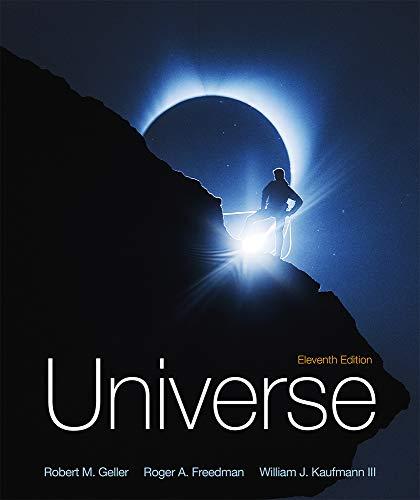
Concept explainers
(a)
The mass of neutrinos in the unit of kilograms and also as a fraction of the mass of the electron, if the Hubble constant is about
(a)
Answer to Problem 46Q
Solution:
Explanation of Solution
Given data:
The Hubble constant has a value of
The critical density has a value of
The average density of dark matter is
The average density of neutrino throughout the space is
Formula used:
The relation between the Hubble law and critical density is presented below.
In the equation, G is the universal constant whose value is
Explanation:
Convert the value of
Recall, the expression for critical density.
Substitute
Average density of dark matter is
In the relation above,
Substitute
The average density of neutrino throughout the space is
Therefore, the mass of the neutrino is obtained from the following calculation.
Substitute
The mass in terms of mass of electron
Conclusion:
The mass of the neutrino in kilograms is
(b)
The reason due to which astronomers do not consider massive neutrinos as the prominent type of dark matter.
(b)
Answer to Problem 46Q
Solution:
The cold matter is the dominant form of dark matter. This suggests that massive neutrinos, which are hot, are not the dominant type of dark matter in the universe.
Explanation of Solution
Introduction:
Dark matter: Dark matter does not emit
Explanation:
Example of hot dark matters are Neutrinos because they comprise of lightweight particles which travel at high speed. Cold matter, on the other hand, comprises of massive particles at low speed.
Massless neutrinos, like photons, always travel at the
In cold matter, the formation of the galaxy takes place from bottom to up means the intersection between filaments occurs. These filaments merge together into galaxies. These galaxies are converted into clusters of galaxies, after which they become superclusters.
On the other hand, hot matter galaxies follow a top to bottom sequence of formation. Observation from the remote galaxies suggests that the formation of matter occurs by “bottom-up” scenario. Thus, hot matter such as massive neutrino is not responsible for formation of galaxies and hence is not the dominant form of dark matter.
Conclusion:
From this observation, it is concluded that the prominent form of dark matter is cold. This suggests that massive neutrinos (which are hot) do not constitute prominent type of dark matter present in the universe.
Want to see more full solutions like this?
Chapter 26 Solutions
Universe
- Explain how centripetal acceleration is affected when the hanging mass changes. Does the graph verify the relationship in equation r = x i + y j = r cosθi + r sinθj?arrow_forwardCan someone help me with this physics 2 problem thank you.arrow_forwardCan someone help me with this physics 2 problem thank you.arrow_forward
 AstronomyPhysicsISBN:9781938168284Author:Andrew Fraknoi; David Morrison; Sidney C. WolffPublisher:OpenStax
AstronomyPhysicsISBN:9781938168284Author:Andrew Fraknoi; David Morrison; Sidney C. WolffPublisher:OpenStax Principles of Physics: A Calculus-Based TextPhysicsISBN:9781133104261Author:Raymond A. Serway, John W. JewettPublisher:Cengage Learning
Principles of Physics: A Calculus-Based TextPhysicsISBN:9781133104261Author:Raymond A. Serway, John W. JewettPublisher:Cengage Learning College PhysicsPhysicsISBN:9781938168000Author:Paul Peter Urone, Roger HinrichsPublisher:OpenStax College
College PhysicsPhysicsISBN:9781938168000Author:Paul Peter Urone, Roger HinrichsPublisher:OpenStax College Stars and Galaxies (MindTap Course List)PhysicsISBN:9781337399944Author:Michael A. SeedsPublisher:Cengage Learning
Stars and Galaxies (MindTap Course List)PhysicsISBN:9781337399944Author:Michael A. SeedsPublisher:Cengage Learning Modern PhysicsPhysicsISBN:9781111794378Author:Raymond A. Serway, Clement J. Moses, Curt A. MoyerPublisher:Cengage Learning
Modern PhysicsPhysicsISBN:9781111794378Author:Raymond A. Serway, Clement J. Moses, Curt A. MoyerPublisher:Cengage Learning University Physics Volume 3PhysicsISBN:9781938168185Author:William Moebs, Jeff SannyPublisher:OpenStax
University Physics Volume 3PhysicsISBN:9781938168185Author:William Moebs, Jeff SannyPublisher:OpenStax





